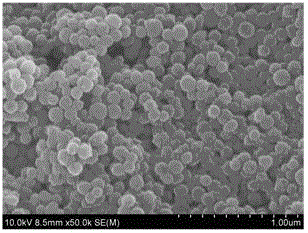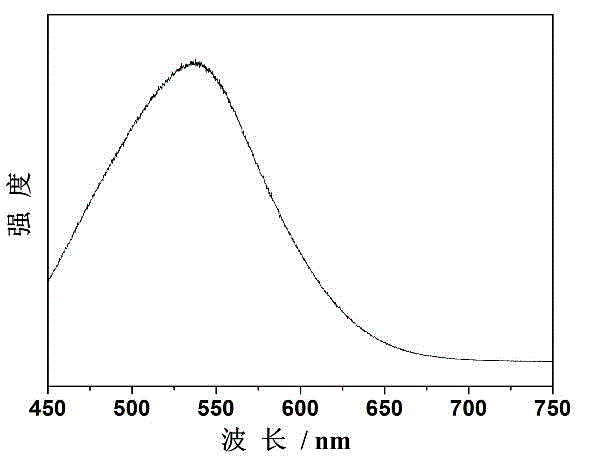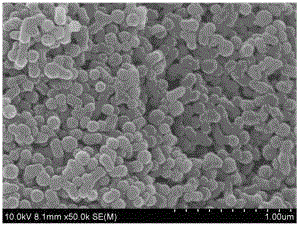Contrast agent having two functions of up-conversion luminescence and magnetic resonance imaging, and method for preparing same
A magnetic resonance imaging and contrast agent technology, applied in the direction of nuclear magnetic resonance/magnetic resonance imaging contrast agents, preparations for in vivo tests, pharmaceutical formulations, etc., can solve the problems of positive contrast agents that have not been reported, and achieve good physical and chemical stability The effect of high stability, stable performance, and strong fluorescence and magnetic resonance signals
- Summary
- Abstract
- Description
- Claims
- Application Information
AI Technical Summary
Problems solved by technology
Method used
Image
Examples
Embodiment 1
[0032] Embodiment one: the specific method is:
[0033] 1. Mix 1 g (3 × 10 -3 mol) soluble starch was dissolved in 20 mL of deionized solution to make a solution with a concentration of 50 g / L, and stirred thoroughly. Transfer the reaction solution into a high-pressure reactor with a 25 ml polytetrafluoroethylene liner, and react at 160??C for 12 hours. After the reaction, the reactor is naturally cooled to about 60??C, and the and deionized water for several times, centrifuged and dried in vacuum to obtain carbon nanospheres.
[0034] 2. Add 3 × 10 to 50 mL DMSO -3 mol DTPA, after completely dissolved, add 3 × 10 -3 mol of NHS and EDC, stirred at room temperature for 24 hours. will be 3 x 10 -3 mol carbon nanospheres are dispersed in the solution, and 3 × 10 -3mol of NHS and EDC, stirred at room temperature for 24 hours. The product was filtered, washed several times with absolute ethanol and deionized water successively, and vacuum-dried to obtain DTPA-modified ca...
Embodiment 2
[0038] Embodiment two: concrete steps are:
[0039] 1. Combine 1.1 g (6 × 10 -3 mol) of glucose was dissolved in 20 mL of deionized solution to make a solution with a concentration of 55 g / L, and stirred thoroughly. Transfer the reaction solution into a high-pressure reactor with a 25 ml polytetrafluoroethylene liner. Under the condition of 200?? C, the reaction time is 6 hours. After the reaction, the reactor is naturally cooled to about 60?? and deionized water for several times, centrifuged and dried in vacuum to obtain carbon nanospheres.
[0040] 2. Add 6 × 10 to 50 mL DMSO -3 mol DOTA, after completely dissolved, add 6 × 10 -3 mol of NHS and EDC, stirred at room temperature for 24 hours. will be 3 x 10 -2 mol carbon nanospheres are dispersed in the solution, add 6 × 10 -3 mol of NHS and EDC, stirred at room temperature for 12 hours. The product was filtered, washed several times with absolute ethanol and deionized water successively, and vacuum-dried to obtai...
Embodiment 3
[0044] Embodiment three: concrete steps are:
[0045] 1. Mix 2.05g (6 × 10 -3 mol) of sucrose was dissolved in 20 mL of deionized solution to make a solution with a concentration of 102.5 g / L and stirred thoroughly. Transfer the reaction solution to a high-pressure reactor with a 25 ml polytetrafluoroethylene liner. Under the condition of 100?? C, the reaction time is 20 hours. After the reaction, the reactor is naturally cooled to about 60?? and deionized water for several times, centrifuged and dried in vacuum to obtain carbon nanospheres.
[0046] 2. Add 6 × 10 to 50 mL DMSO -3 mol DTPA-BMA, after complete dissolution, add 6 × 10 -3 mol of NHS and EDC, stirred at room temperature for 24 hours. will be 2 x 10 -2 mol carbon nanospheres are dispersed in the solution, add 6 × 10 -3 mol of NHS and EDC, stirred at room temperature for 6 hours. The product was filtered, washed several times with absolute ethanol and deionized water successively, and vacuum-dried to obt...
PUM
 Login to View More
Login to View More Abstract
Description
Claims
Application Information
 Login to View More
Login to View More - R&D
- Intellectual Property
- Life Sciences
- Materials
- Tech Scout
- Unparalleled Data Quality
- Higher Quality Content
- 60% Fewer Hallucinations
Browse by: Latest US Patents, China's latest patents, Technical Efficacy Thesaurus, Application Domain, Technology Topic, Popular Technical Reports.
© 2025 PatSnap. All rights reserved.Legal|Privacy policy|Modern Slavery Act Transparency Statement|Sitemap|About US| Contact US: help@patsnap.com



